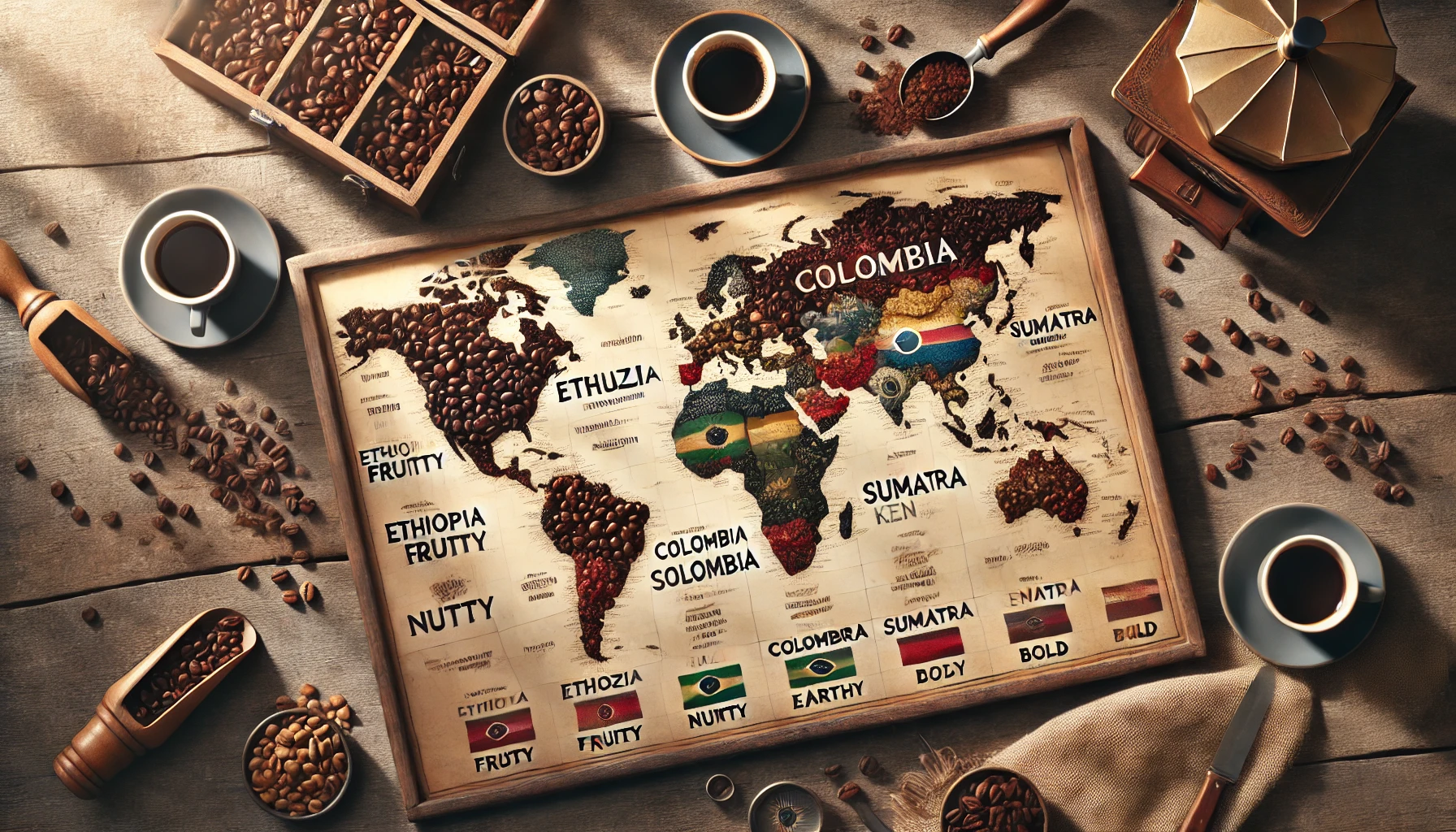Ever wondered why coffee from Ethiopia tastes fruity and floral, while coffee from Brazil tends to be nutty and chocolatey? Why your cup from Colombia might feel smooth and balanced, but a Sumatran roast hits your palate with deep earthy tones?
The answer lies in the complex and fascinating world of coffee terroir, farming practices, bean varieties, and processing methods. In this article, we’ll explore the many factors that influence how coffee tastes, and why your experience can vary dramatically depending on where the beans were grown.
By the end, you’ll understand how geography shapes flavor — and how to choose beans based on your taste preferences, not just your budget.
What Is “Terroir” and Why Does It Matter?
“Terroir” (pronounced ter-wahr) is a French term that means “sense of place”. It refers to how local environmental factors like soil, climate, altitude, and rainfall affect the taste and quality of agricultural products — including wine, chocolate, and coffee.
In coffee, terroir influences everything from acidity and sweetness to body and aroma. Two farms growing the same variety of Arabica coffee can produce beans with totally different flavor notes if they’re in different countries, or even on opposite sides of the same mountain.
Some of the most important terroir factors include:
- Altitude: Higher altitudes usually produce more acidic and complex coffees.
- Climate: Temperature and rainfall affect how slowly the cherries ripen, impacting sugar development.
- Soil composition: Rich, volcanic soils often yield vibrant and bold flavors.
- Sun exposure and shade: Influence cherry maturation and density.
Understanding terroir helps explain why Ethiopian coffee often tastes like berries, while Sumatran coffee can feel heavy and spicy.
The Role of Coffee Varieties (Like Grapes in Wine)
Just like wine has different grape varieties (e.g., Cabernet Sauvignon, Pinot Noir), coffee has many botanical varieties, each with its own characteristics.
Here are some common ones:
- Typica: One of the oldest and most widespread varieties, known for smooth, sweet flavor.
- Bourbon: Offers complex acidity and good body — often found in Central and South America.
- SL28 & SL34: Cultivated in Kenya, known for bold, citrusy profiles.
- Geisha (or Gesha): Originating from Ethiopia but popularized in Panama — known for floral, tea-like elegance and very high prices.
- Caturra, Catuai, Pacamara: Other Latin American varieties with diverse cup profiles.
The variety of coffee grown can dramatically affect taste — and when combined with specific terroir, it creates the unique fingerprint of a region’s coffee.
Processing Methods: From Cherry to Bean
After coffee cherries are harvested, they must be processed to remove the pulp and dry the beans. This step is critical for flavor development.
The main processing methods include:
- Washed (wet-processed): The pulp is removed with water. Produces clean, bright, and acidic flavors. Common in Colombia, Ethiopia, and Kenya.
- Natural (dry-processed): The whole cherry is dried before removing the husk. Results in fruity, sweet, and heavier flavors. Used in Ethiopia, Brazil, and Yemen.
- Honey process (semi-washed): A hybrid method where some pulp is left on the bean during drying. Produces a balance of sweetness and clarity. Popular in Costa Rica and Nicaragua.
Different processing methods can make a huge difference, even if the beans come from the same region. That’s why two Ethiopian coffees might taste very different if one is washed and the other natural.
Roast Profiles: The Roaster’s Influence
Roasting also plays a massive role in coffee flavor. While terroir and processing set the foundation, roasting brings the flavor to life — or masks it entirely.
Roast types include:
- Light Roast: Preserves origin flavors, higher acidity, fruity or floral notes
- Medium Roast: Balanced flavor, moderate acidity and body
- Dark Roast: Roasty, bitter, smoky — origin characteristics are often subdued
For example, a light-roasted Ethiopian might taste like blueberries and jasmine, while the same beans roasted dark might taste like ash and cocoa.
If you want to explore global flavors, stick to light and medium roasts, which allow terroir and processing notes to shine.
How Altitude Affects Taste
Coffee grown at high altitudes (over 1,200 meters / 4,000 feet) tends to develop more complex flavors. Why?
- The cooler temperatures slow down cherry maturation
- Slow growth allows more sugars to develop in the bean
- Beans become denser, which often results in more vibrant and nuanced cups
That’s why high-altitude coffees from Colombia, Ethiopia, Kenya, and Guatemala often score high in specialty rankings.
In contrast, lowland coffees — like many from Vietnam or large Brazilian estates — ripen faster and tend to have simpler, nutty, or chocolatey profiles.
Popular Coffee-Growing Regions and Their Flavors
Here’s a snapshot of some well-known coffee origins and what you can expect from their beans:
Ethiopia
- Often floral, fruity, citrusy
- High altitude and heirloom varieties
- Both natural and washed methods used
Colombia
- Balanced, smooth, mild acidity
- Wide variety of microclimates and altitudes
- Mostly washed processing
Brazil
- Nutty, chocolatey, low acidity
- Low to medium altitude
- Natural and pulped natural processes
Kenya
- Bold, wine-like acidity, blackcurrant notes
- High altitude, SL varieties
- Washed processing
Sumatra (Indonesia)
- Earthy, spicy, full-bodied
- Wet-hulled processing unique to the region
- Often used in espresso blends
Guatemala
- Rich, chocolatey with some fruit notes
- Volcanic soil, high elevation
- Washed processing
Honduras, Costa Rica, Nicaragua
- Balanced and sweet, often caramel or citrus
- Great for honey processing
Taste and Brewing Method: A Final Twist
Believe it or not, how you brew your coffee can also influence how you perceive the regional flavors. For example:
- Pour-over methods (like V60 or Chemex) highlight brightness and clarity, great for fruity African coffees.
- French press emphasizes body and richness, ideal for bold Latin American beans.
- Espresso intensifies flavors and can magnify bitterness or sweetness, depending on the roast.
- Cold brew tends to smooth out acidity and bring out chocolate or nutty notes.
So even your preferred brewing style can influence which regional flavors you enjoy most.
Final Thoughts: A World of Flavor in Every Cup
Coffee isn’t just a drink — it’s an experience shaped by geography, climate, farming, and tradition. Every region brings something different to the cup, and every choice — from bean to brew — shapes the final flavor.
Next time you sip your favorite roast, take a moment to consider its origin, process, and journey. You might discover that your preferences are connected not just to flavor, but to a part of the world with its own coffee story.
So go ahead: explore, taste, and travel the world through coffee — one cup at a time.

